Health
Hyrox Workout: How to Train for the Hottest New Fitness Race

Curious about the global fitness race that’s exploded in popularity? The Hyrox workout has been incorporated into boutique and big box gym regimens and no doubt infiltrated your Instagram feed.
Hyrox is a smorgasbord of cardio and functional fitness that marries running with exercises like wall balls, sled pushes, and rowing. The event hosts competitions across North America, Europe, Asia, and Oceania, with the 2024 season including over 60 races in 11 countries and 30 cities, often selling out in popular locales in a matter of minutes.
We’re giving you the low down on the Hyrox workout: where it started, what it entails, and, most importantly, how to maximize your training.
What Is Hyrox?
Hyrox started in Germany in 2017 by Christian Toetzke, a longtime organizer of endurance events like triathlons, marathons and cycling races, and Moritz Furste, a German field hockey player and three-time Olympic medalist.
In the 2022/2023 season, over 90,000 athletes competed. A single event can include as many as 8,000 participants and 10,000 spectators, which is why the company calls itself the “world’s largest mass participation fitness race.”
While Hyrox hosts a highly competitive World Championships, the company says it “welcomes every participant with open arms.” To help alleviate concerns about being the last person to cross the finish line, a new wave of athletes starts every 10 minutes throughout the entire race day. According to the company, over 98 percent of athletes complete the race.
Additionally, the competition offers four divisions:
- Open, best for individuals who are just starting out
- Pro, for experienced racers
- Doubles, where you and a partner partition the workout stations
- Relay, where the work is split among four people.
What Is the Hyrox Workout?
Unlike a CrossFit competition, where the workouts are typically new and sometimes remain unknown until just before the athletes step on the floor, the format of a Hyrox workout is always the same: eight rounds of a 1-kilometer run followed by a station.
The exercises are always the same:
- SkiErg
- Sled push
- Sled pull
- Burpee broad jumps
- Rowing
- Farmer’s carry
- Sandbag lunges
- Wall balls
The average time for a Hyrox workout is around 80 to 90 minutes, and the benefits are that it tests your strength, power, core stability, stamina, and coordination, says James Kelly, Hyrox coach and winner of the most recent Australian Hyrox race. However, what’s most importance is your endurance: “By far the biggest thing I’ve learned is that this is a running race before anything else.”
In addition to increasing your VO2 max, you’ll want to prioritize glute exercises, leg exercises, abs exercises, back exercises, and arm exercises.
Here’s how to do each movement in the Hyrox workout—plus a snapshot of the reps, distance, and weight by group.
| Women | Women Pro | Men | Men Pro | |
|---|---|---|---|---|
|
SkiErg |
1,000m |
1,000m |
1,000m |
1,000m |
|
Sled Push |
4 x 12.5m at 75kg (plus sled) |
4 x 12.5m at 125kg (plus sled) |
4 x 12.5m at 125kg (plus sled) |
4 x 12.5m at 175kg (plus sled) |
|
Sled Pull |
4 x 12.5m at 50kg (plus sled) |
4 x 12.5m at 75kg (plus sled) |
4 x 12.5m at 75kg (plus sled) |
4 x 12.5m at 125kg (plus sled) |
|
Burpee Broad Jump |
80m |
80m |
80m |
80m |
|
Rowing |
1,000m |
1,000m |
1,000m |
1,000m |
|
Farmer’s Carry x 200m |
2 x 16kg |
2 x 24kg |
2 x 24kg |
2 x 32kg |
|
Lunges |
100m at 10kg |
100m at 20kg |
100m at 20kg |
100m at 30kg |
|
Wall Balls |
75 x 4kg |
100 x 6kg |
100 x 6kg |
100 x 9kg |
SkiErg

Courtesy Image
How to Do It
- Grip the handles with a slight bend in your elbows and stand about an arm’s length away from the machine, to start.
- Rise to the balls of your feet, reach arms up, then pull down hard, sending hips back and fists toward the ground, dropping into a slight crouch.
- Immediately push through heels to reverse, then pull again.
- Your upper body supplies the force for the first part of the pull, then your lower body (glutes especially) power the tail end.
Pro Tip
Resist the urge to go all-out. Remember, this is the first station and burning out too soon spells disaster for the rest of the race. The SkiErg has a flywheel with a lever to control resistance and a digital display to track splits. For sprint training, keep the tension at 5 to 8, and use distance traveled for each interval to ensure consistency throughout reps. If you’re training for endurance, bump it down to a 4 or 5 and set a distance to cover. The damper in competition is set to the following resistance, according to division:
- Women: 5
- Women Pro/Men: 6
- Men Pro: 7
You can adjust the damper to whatever resistance you like, just note you’re not allowed to change it once you start.
Sled Push

Courtesy Image
How to Do It
- Set the sled with the weight you’ll be using in competition, to start.
- Determine which stance you’ll use or play with a combination: arms straight out with hands on high poles, hands on high poles with elbows tucked in, arms wrapped around the high poles, or arms wrapped down the poles.
- Hinge hips forward slightly and lean into the sled with your back straight and core engaged.
- Drive through the balls of your feet and push the sled with small, quick steps.
- You must stay within the designated lines of the Athlete’s Box and push the sled over the line on each rep.
- Penalty: If you complete less than four reps (lanes), you’ll get a penalty of 3 minutes per missing lane.
Note: In competition, you must cover 50m and Hyrox sleds weigh approximately 30 kg so overall weight is as follows:
- Women: 102kg
- Women Pro: 152kg
- Men: 152kg incl. sled
- Men Pro: 202kg incl. sled
- Mixed Doubles: 152kg incl. sled
- Women Doubles: 102kg incl. sled
Pro Tip
Taller participants might find the close-grip stance easier to gain momentum (arms bent, elbows tucked, hands on high bars), while shorter athletes might find arms extended better as they’re at a level height with the bars. If you’re too high over the sled and push down, you’ll cause it to tip and dig into the turf. Think about keeping a proud chest as you push the sled and stay as low and level as you can.
Sled Pull
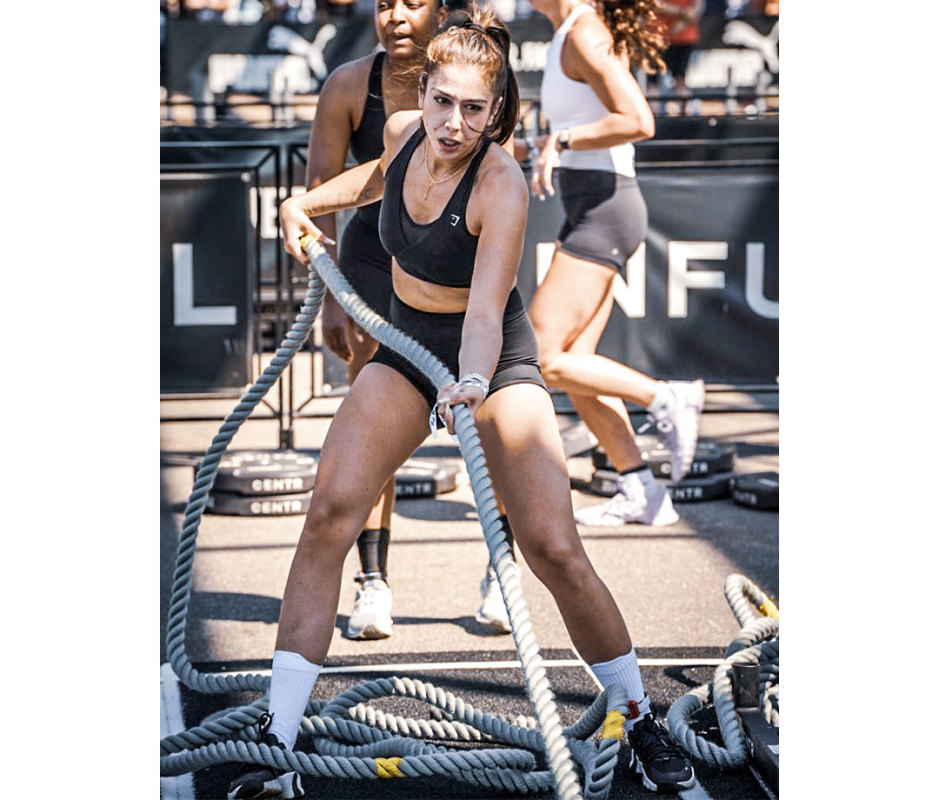
Courtesy Image
How to Do It
- Assume an athletic stance, feet just wider than shoulder-width apart, to start.
- One technique will spare your legs and put the emphasis on your upper body: Grasp the rope with both hands and engage your lats to pull the rope toward one side of your body (shown), alternating which hand reaches forward, letting the rope coil behind you and to the side.
- The second technique engages the lower body to even the strain: Come into a quarter-squat position, then drive through your legs and extend through your hips as you simultaneously pull the rope toward you with both hands to gain more momentum.
- You must pull from a standing position at all times (no kneeling) and must stay within the designated lines of the Athlete’s Box.
- Penalty: Taking any steps forward between repetitions is not allowed. If you violate any of these rules, the rep is void and needs to be repeated; moreover, a second warning warrants a 5m penalty.
Pro Tip
Don’t let the rope pool and coil at your feet. You increase your odds of tripping over it.
Burpee Broad Jumps
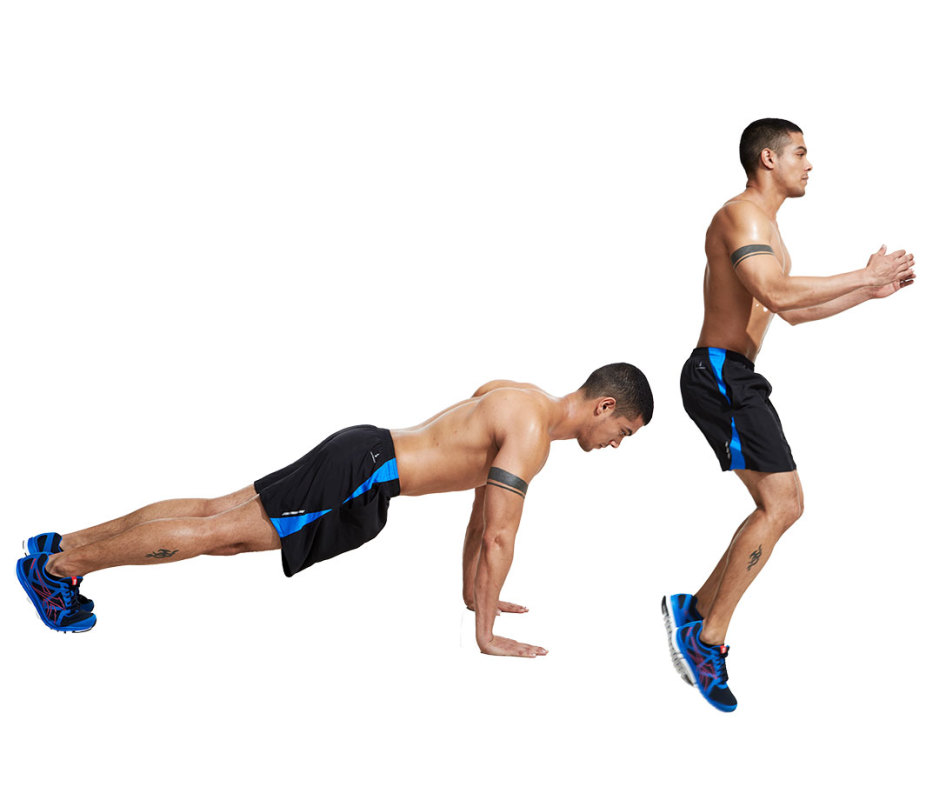
Beth Bischoff
How to Do It
- From a standing position, bend down and touch your hands to the ground, behind the designated line, to start. Your hands can only be one foot-length away to meet Hyrox rules and once on the ground, they can’t move forward.
- Drop your chest to the ground (it must touch) and shoot your legs out behind you so you’re in the bottom position of a pushup.
- Step or jump your feet to stand, then jump forward, landing with both feet simultaneously.
- Penalty: Taking any steps forward between the repetitions is not allowed. If you violate any of these rules, the rep is void and needs to be repeated; moreover, a second warning warrants a 5m penalty.
Pro Tip
Step your feet together to stand, then jump forward to preserve energy. If you want to jump throughout the duration of the station, stay low and keep your body tipped forward to jump like a frog and maintain momentum.
Rowing

Courtesy Image
How to Do It
- Adjust the foot stretcher according to your shoe size so the straps are aligned with your midfoot, to start.
- Hold the handle at both ends, starting at the catch, where the handle is closest to the monitor. Angle your body forward so your shoulders are in front of your hips and arms are straight in front of you.
- Initiate the drive with your legs (think of a power clean). When your legs are almost straight, swing your body open while still keeping your arms straight.
- When your body is just past perpendicular, pull your arms into your body to finish the stroke (handle should be near sternum).
- Let your arms and body reset before you start the slide and bend your knees.
The damper in competition is set to the following resistance, according to division:
- Women: 5
- Women Pro/Men: 6
- Men Pro: 7
You can adjust the damper to whatever resistance you like, just note you’re not allowed to change it once you start.
Pro Tip
A common mistake is relying on the upper body and arms to power the movement. Rowing is more about the connection between your hips and core. Maintain a steady pace so you don’t burn out.
Farmers’ Carry
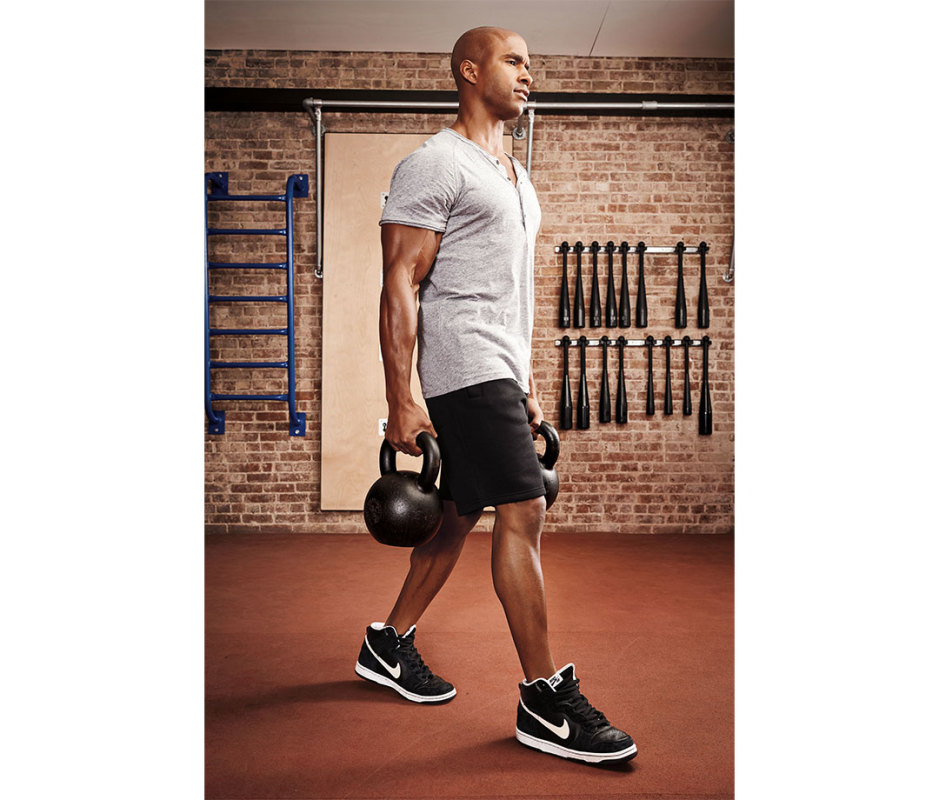
James Michelfelder
How to Do It
- Stand tall with a kettlebell in each hand, to start.
- Maintain a tall chest, retract shoulder blades, and keep weights from resting on thighs.
- Walk forward, using choppy, heel-to-toe steps.
- Ensure that your head is facing forward and your posture is rigid. You may rest the kettlebells on the ground if you need to reset.
Pro Tip
The Centr x HYROX Octo Kettlebell designed for competition has a flattened, eight-sided design for even weight distribution and to better carry the bells by your sides; they stay flush rather than bouncing around. Hold the horns at the front of the bell rather than the center so they tip back. This will lessen the strain on your grip strength, as the weights naturally hang back so you don’t need to hold them so tightly. Try to move quickly through this station to minimize time under tension.
Sandbag Lunges

Courtesy Image
How to Do It
- Start with feet hip-width apart and the sandbag in front of you, to start.
- Grab the handles and clean the bag to your chest, press it overhead, then rest it on your shoulders behind your neck.
- Keeping your torso upright, lunge forward with left foot until right knee grazes the floor.
- Press through left foot to stand; then lunge forward with your right foot until left knee kisses the ground. Continue alternating on each rep.
- Penalty: You must not take any steps in between lunges, nor can you drop the sandbag. If you’re competing with a partner, you must transfer the sandbag back-to-back without lowering it. Failure to do so with incur a 5m penalty. If competing in Doubles, the non-working partner walks behind the working partner, however if they obstruct other participants, a 10m penalty is issued.
Wall Balls

Courtesy Image
How to Do It
- Stand facing a sturdy wall or wall ball target, with feet slightly wider than shoulder-width apart, elbows bent at rib cage, ball under chin, to start.
- Drop hips into a low squat (hips must descend below 90 degrees), then drive up with legs, extending arms overhead to toss the medicine ball to the target.
- Women must hit the 9-foot target in the center and men must hit the 10-foot target in the center.
- Catch and use the ball’s momentum to return to a squat and repeat.
Pro Tip
Make a strategy. Since this is the last event, you’ll likely need to break the reps into sets to shake your arms out and take a breather in between.
Expert Tips for Hyrox Workouts
1. Treat Running Like a Skill
Because running is so fundamental to the Hyrox workout, Kelly recommends first-timers treat it as a skill they need to work on.
“You have to look at your running technique, volume, and training program,” he says. The key, he adds, is to get enough volume under your legs by doing this: Estimate how long the entire race will take, including the 8km (nearly 5 miles) of running and the eight workout stations. If that’s 90 minutes, you should work up to being able to run for 90 minutes straight. “Take it nice and slow,” he says, “no intensity whatsoever.”
Along those lines, Kelly says the biggest mistake he sees is people focusing too much on speed.
“They think the way to get faster is to go as hard as possible in their workouts,” he says, which is counterintuitive. “If you try to run 400 meters as fast as possible, your technique will break down, and you’re teaching yourself to run poorly.”
2. Train the Sled Pull and Push in Isolation
As for the workout stations, in Kelly’s experience as a coach and an athlete, the two most difficult movements are the sled pull and push. He recommends training these movements in isolation. Then, about a month out from the race, you can incorporate them into a larger workout with running and the other stations. “It blends in all together all by itself,” he says.
3. Practice Pacing
On race day, pacing is everything. Because the Hyrox workout will likely be at least an hour of non-stop movement, “there’s no point in going out too hot,” Kelly says. And because running is so essential, he suggests you pull back on a station so you can jump straight into the run when you finish. As you get more experience, you’ll naturally start to understand where you can push the tempo and where to hold back.
4. Get the Right Equipment
To simulate a Hyrox workout, you don’t necessarily need a specialized gym, but it’s best to have certain equipment that’s difficult to replicate, like the SkiErg and the rowing machine. If you don’t have a sled to push, Kelly points out that this is a unilateral movement (e.g. one leg a time), so you can sub in any comparable exercise, like heavy walking lunges, heavy box stepups, or heavy Bulgarian split squats. Similarly, for the sled pull, you just need to work your posterior chain through deadlifts (or deficit deadlifts), rope pulls, lat pulldowns, and bentover rows.
5. Practice the Race
Apart from that accessory work, and focusing on each of the stations in isolation, Kelly says the best way to prepare is to do some version of the race—especially if you’re just beginning your Hyrox workout journey. You don’t need to go full-send beforehand, but try these routines to familiarize yourself with the Hyrox workout.
Simulation Hyrox Workout #1: The Half-Race
- 500-meter run
- 500-meter SkiErg
- 500-meter run
- 25-meter sled push (152kg for men, 102kg for women)
- 500-meter run
- 25-meter sled pull (103kg for men, 78kg for women)
- 500-meter run
- 40-meter burpee broad jump
- 500-meter run
- 500-meter row
- 500-meter run
- 100-meter farmers carry (2 x 24 kg for men, 2 x 16kg for women)
- 500-meter run
- 50-meter sandbag lunges (20kg for men, 10kg for women)
- 500-meter run
- 50 wall balls (6kg for men, 4kg for women)
Simulation #2: The Two-a-Day
In the morning:
- 1-kilometer run
- 1-kilometer SkiErg
- 1-kilometer run
- 50-meter sled push (152kg for men, 102kg for women)
- 1-kilometer run
- 50-meter sled pull (103kg for men, 78kg for women)
- 1-kilometer run
- 80-meter burpee broad jump
In the afternoon:
- 1-kilometer run
- 1-kilomter row
- 1-kilometer run
- 200-meter farmers carry
- 1-kilometer run
- 100-meter sandbag carry (20kg for men, 10kg for women)
- 1-kilometer run
- 100 wall balls (6kg for men, 4kg for women)
Simulation #3: The Partner Workout
You and your partner must complete all the running together, but you can partition the work stations however you like.
- 1-kilometer run
- 1-kilometer SkiErg
- 1-kilometer run
- 50-meter sled push (152kg for men, 102kg for women)
- 1-kilometer run
- 50-meter sled pull (103kg for men, 78kg for women)
- 1-kilometer run
- 80-meter burpee broad jump
- 1-kilometer run
- 1-kilometer row
- 1-kilometer run
- 200-meter farmers carry
- 1-kilometer run
- 100-meter sandbag carry (20kg for men, 10kg for women)
- 1-kilometer run
- 100 wall balls (6kg for men, 4kg for women)
Health
Zucchini Baby Food Puree | The Picky Eater

This post may contain affiliate links. As an Amazon Associate, I earn from qualifying purchases. Please read my disclosure.
Perfect for busy parents looking to make their own baby food, my easy zucchini baby food with apples and carrots is a delicious combination your baby will love! Both zucchini and carrots are sweeter veggies, and when paired with apples, it turns a simple zucchini puree into a healthy sweet treat for your little one.

Veggies mixed with fruit are always a hit in my household, and this zucchini carrot and apple puree is a favorite. When my kids were young, I used to mix this zucchini baby food with their oatmeal in the morning and they loved it!
While you can easily take zucchini and make a one ingredient puree, I always loved experimenting with different zucchini combination baby food to see what my baby enjoyed most. I find that mixing it with a couple of other fruits and veggies makes babies love it even more!
So if you haven’t tried making a zucchini carrot puree for your little one, my simple recipe is easy to prepare, nutritious, and delicious. I guarantee you will have one happy baby after giving them this smooth puree!
My zucchini baby food recipe is a great first food! Babies can enjoy zucchini as young as 6 months old when they begin to try other solid foods (source). I gave my kids this courgette baby puree when they were both 6 months old, and they totally loved it!
Baby food recipes with zucchini are packed with vitamins and minerals. Zucchini is a great source of beta-carotene, which converts to vitamin A, supporting the immune system and improving eyesight. Additionally, it’s rich in vitamin C, aiding in iron absorption, which is crucial as babies begin to lose iron around 5 months old. It also contains vitamin B6, essential for brain development (source).
My zucchini and carrot puree for baby is not only healthy but also delicious. It combines the natural sweetness of fresh zucchini, carrots, and apples, creating a flavor that your little one will love with every spoonful.
I’ve also found that using zucchini can be of the best stage 1 baby food recipes because it’s so mild and typically not on the list of common food allergies.
Plus, it’s the most versatile and easiest baby food zucchini recipe ever! You don’t need any fancy equipment or expensive ingredients to make this – just a pot and a blender or potato masher and you’re all set.
My zucchini puree is a simple baby food recipe you can use in a variety of ways – it’s super customizable based on your baby’s needs and preferences.
Not only that, but baby food with zucchini keeps well in the fridge and freezer! My recipe makes 16 servings, so I would often make it in big batches to have on hand, making meal planning for my kids much easier and more efficient!
Latest Recipe Video!
🥘 Ingredients
My homemade baby puree with zucchini is ready in minutes with minimal effort. All you need is a handful of simple ingredients and a good blender! Scroll down to the recipe card at the bottom of the post for more details.

Organic Zucchini: This mild flavored veggie forms the base of my zucchini carrot baby food! I prefer to use the smaller, skinnier zucchini for baby food because they have fewer seeds. You could also make this recipe with yellow squash or summer squash if you don’t have zucchini.
Organic Carrots: They add sweetness and a smooth texture to the puree. You can use either large carrots or baby carrots.
Organic Fuji Apples: I love using Fuji apples for their sweet and crisp flavor. They are excellent for baby food puree as they easily cook down and add natural sweetness.
Water: You need liquid to help the fruits and veggies cook down. I use 12 ounces of water so that the puree ends up with a smooth and easy-to-consume consistency.
🔪 How To Make Zucchini Baby Food
Learning how to puree zucchini for baby food is really easy! It only takes a few simple steps and the blender does all the hard work for you.
Watch my video below to see the step-by-step process of making zucchini puree for baby.
Prep Your Ingredients: To begin I wash all the produce. Then I cut the zucchini in half lengthwise and cut each half into 8 pieces. Next, I peel the carrots, cut them in half lengthwise, and then cut each half into 8 pieces. For the apples, I cut them in half, remove the seeds and stem, and cut each half into 8 pieces.
Cook The Produce: In a large pot, I add the carrots and water. Then I turn the heat to high and cook for 8 minutes, stirring occasionally. Next, I add the zucchini and apples and cook for another 3-5 minutes.
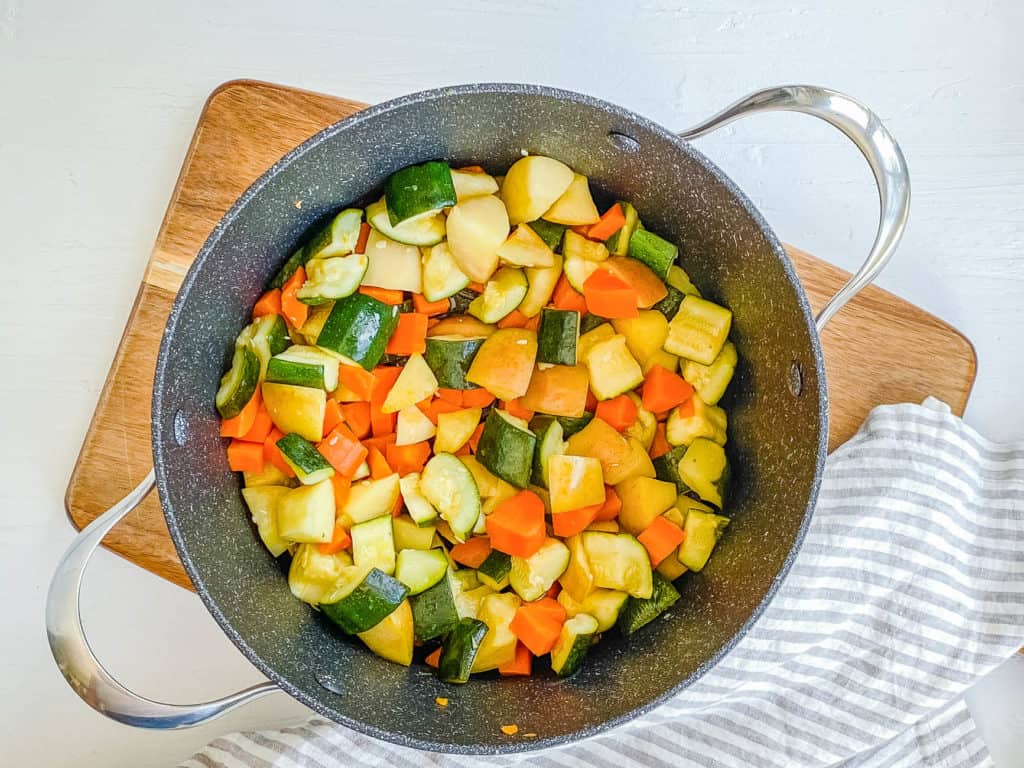
Puree The Mixture: When done I pour the cooked produce and water into a blender. Then I blend everything until smooth or the desired consistency.

Serve or Store: After blending, if I’m not serving the pureeright away or using it all within a week, I pour it into ice cube trays. Then I let it cool, wrap or cover the trays, and put them in the freezer.
Note: Thaw in the fridge the night before use, or thaw by putting the small cubes in a bowl over a bowl of hot water on the counter to defrost.
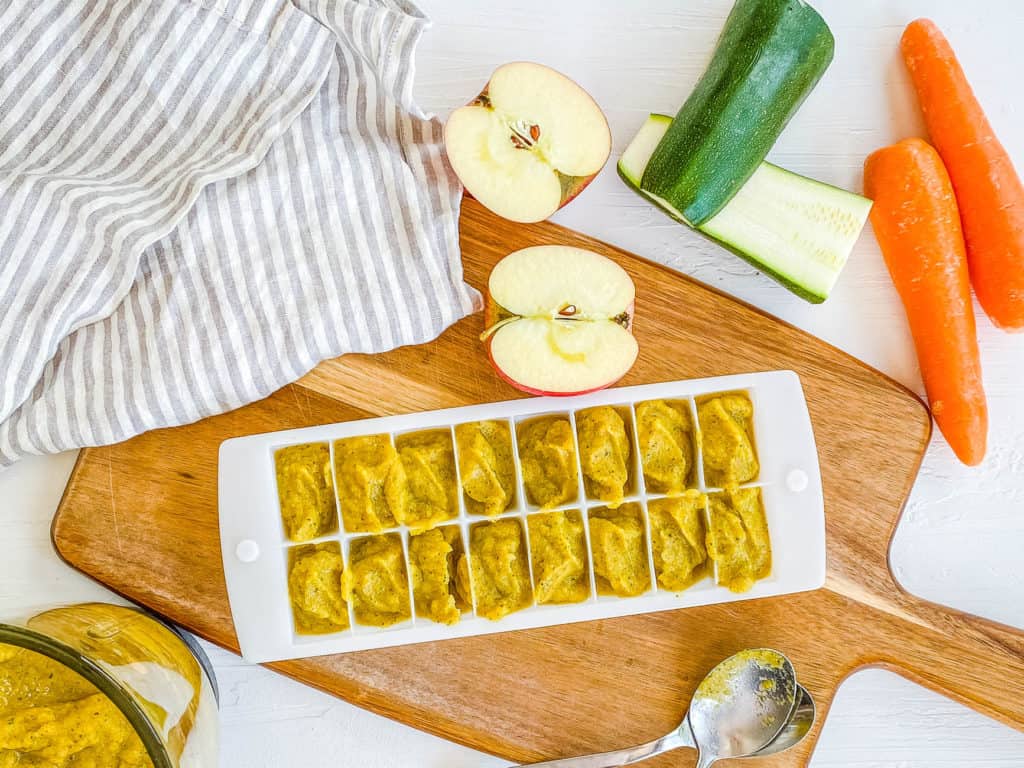
My #1 Secret Tip or making my zucchini baby food is to use a high-speed blender, not a food processor. A high-speed blender will pulverize all the ingredients into a super smooth consistency. A food processor might leave the puree slightly chunky or grainy.
Other Tips To Keep In Mind:
- Use Organic Produce If You Can: When making your own homemade baby food recipes, I highly recommend using organic produce to reduce pesticide exposure for your baby. No matter how thoroughly you wash your fruits and vegetables, there will still be some pesticide residue (source).
- Proper Storage: Before using the zucchini, make sure it’s completely dry. Then place them in a paper bag and store them in the vegetable drawer of your fridge. Don’t put them in a plastic bag – it will cause your courgette to become slimy.
- Steaming Option: Instead of boiling, you can also use a steamer basket or slow cooker. To steam zucchini for baby food first dice everything into small chunks. Next, bring 1 inch of water to boil in a pot with a steamer basket, add the produce, cover, and steam for 5 minutes until soft. Then put the steamed zucchini and veggies into a blender with a little water and puree.
- Speed Up Cooking: For quicker cooking time, cut the vegetables and fruit into small pieces to help them cook down more quickly.
- First-Time Feeding: If this is your first time serving zucchini to your baby, monitor for any allergic reactions over the first 1-3 days. Once you confirm there are no allergies, you can start mixing zucchini with other purees.
✔️ How To Choose Zucchini
Zucchini, also known as courgette in some countries, is the exact same vegetable. When selecting zucchini, you want to look for vibrant, bright green ones that are firm and free of bruises or blemishes.
Size is important too. I prefer smaller, skinnier zucchini for baby food because they have fewer seeds in the center. Choose small to medium-sized zucchini, as they have less water content and more flavor compared to larger ones. Larger zucchinis tend to be watery, less flavorful, and full of seeds.
📖 Variations
One of the best things about this recipe is how customizable it is. When creating your own variations choosing what to mix with zucchini for baby food is fun. Here are some of my favorite zucchini baby food combinations:
Use Different Veggies: This is just a short list of some other vegetables that would taste great with my zucchini puree.
Change The Fruit: Use a different type of apple in this delicious puree, or add one of these other fruits for a fun way to change things up!
Add Spices Or Herbs: All zucchini puree combinations for baby are delicious with the addition of herbs and spices such as basil, thyme, rosemary, parsley, garlic, or lemon. If you want a sweeter flavor, try a pinch of cinnamon or nutmeg. It’s a great way to expose babies to new flavors.
Add Breast Milk or Formula: When considering what to mix zucchini with for baby, it can be as simple as just mixing in some breast milk or organic baby formula to thin out the consistency of the puree right before serving. Do not add breastmilk or formula before freezing the baby food as formula is not meant to be frozen, and breastmilk has a different shelf life in the freezer.
Make A Single Ingredient Puree: If you don’t have everything on hand to make carrot zucchini and apple puree, no problem! You can make plain zucchini puree! Just add the zucchini and a few tablespoons of water to a pot, boil, and then puree. Keep in mind that zucchini has a lot of water, so if you don’t add the carrots and apples, you may need less water.
Make Baby Finger Foods: Turn my courgette puree for baby recipe into finger food instead. For older babies, or babies who are using baby led weaning foods, you can cut the zucchini into match-sized sticks, and roast them in the oven with a little bit of olive oil. They turn into zucchini “fries” and are a great way for your baby to experiment with gumming soft foods.
🧊 Storage Directions
Fridge: If you plan to use the entire batch of zucchini baby puree within a week, I recommend just transferring it to an airtight container and storing it in the refrigerator. Simply scoop out individual servings as needed.
Freezer: For longer storage, pour the cooled puree into ice cube trays, cover, and freeze until solid. Once frozen, I always transfer the cubes to a ziplock freezer bag and label it with the date. The cubes can be stored in the freezer for up to 3 months.
Thawing: To thaw, I normally place the desired number of cubes in the fridge overnight. Alternatively, for quicker thawing, you can place the cubes in a bowl over another bowl of hot water on the counter.
Reheating: Gently warm the thawed puree in a saucepan over low heat or in a microwave-safe dish in the microwave. Stir well and test the temperature before serving to ensure it’s not too hot for your baby.
❓Recipe FAQs
No, do not give your baby raw zucchini. They cannot mash it with their gums, and the small pieces can be a choking hazard.
You don’t need to remove the seeds – it is fine for baby to eat zucchini seeds when they are pureed with the rest of the zucchini.
You might be wondering whether you need to peel the zucchini skin before cooking it. The answer is no – you definitely don’t need to peel the zucchini. The zucchini skin has a ton of nutrients and becomes super soft when cooked, which means it’s ideal for pureeing.

Want to Save This Recipe?
Enter your email & I’ll send it to your inbox. Plus, get great new recipes from me every week!
By submitting this form, you consent to receive emails from The Picky Eater.
Love this plant based baby food recipe? Please leave a 5-star rating 🌟 in the recipe below and/or a review in the comments section further down the page!
You can also FOLLOW ME on FACEBOOK, INSTAGRAM, and PINTEREST to see more delicious, healthy, family-friendly food, and if you have any questions, I’m here to help!
📋 Recipe Card
Zucchini Baby Food Puree
My zucchini baby food puree with apples and carrots is a delicious combination your baby will enjoy! Zucchini and carrots are on the sweeter side in the vegetable category, and when paired with apples it becomes a healthy sweet treat for your little one!
Servings: 16 ounces
Calories: 22kcal
- Store zucchini in a paper bag in the fridge to keep fresh.
- If you don’t want to boil everything in a pot, you can also use a steamer basket or slow cooker to cook down the vegetables and fruit.
- Cut the vegetables and fruit into small pieces to help them cook down more quickly.
- If you plan to use this entire batch of zucchini baby food within 1 week, you can transfer the entire puree into one airtight container and place it in the fridge. Then, just scoop out individual servings when you’re ready to feed your baby.
- 1 ice cube = 1 oz of food
Adapted from BabyLove
Calories: 22kcal | Carbohydrates: 5g | Protein: 1g | Fat: 1g | Saturated Fat: 1g | Sodium: 13mg | Potassium: 144mg | Fiber: 1g | Sugar: 4g
Health
The Hidden Time Bomb That Will Destroy Your Marriage and The Secret for Defusing It

Too many marriages are failing today and even trained marriage counselors don’t know why. I have been a marriage and family therapist for more than fifty years and the headline on my website “Confessions of a Twice-Divorced Marriage Counselor” introduces you to what I’ve learned in my own life and what I have done to help thousands of men and women recognize that divorce is not the answer. Spoiler alert: My present wife Carlin and I have been married for 45 years now and our love grows stronger every year.
I could write a lot and tell you the full story, but I’m guessing you’d appreciate my getting right to the point and telling you what the time bomb is and the secret for defusing it.
The hidden bomb causes changes in our brains when we grow up with a “father wound” and the secret for defusing it is to change the false beliefs that were planted in our brains that undermine our relationships.
Although this deadly time bomb can explode at any time in a marriage, mid-life couples are particularly vulnerable. Susan L. Brown is Director of The National Center for Family & Marriage Research. In a recent article, “The Graying of Divorce: A Half Century of Change,” she offers the following facts:
- People over 50 are divorcing in record-breaking numbers, and three to four-family generations feel the effects.
- 1 in 4 persons who divorce in the U.S. is over 50, contrasted to less than
1 in 10 in 1990.
- As the divorce rate for adults over 50 soars, so does the number of adult children experiencing parental divorce.
- In their book Second Chances: Men, Women and Children a Decade After Divorce, Sandra Blakeslee and Judith S. Wallerstein tell us, “Divorce is deceptive. Legally it is a single event, but psychologically it is a chain – sometimes a never-ending chain – of events, relocations, and radically shifting relationships strung through time, a process that forever changes the lives of the people involved.”
Understanding and Healing The Family Father Wound
Although I had written a number of books that helped me understand what causes relationships to fall apart, including international best-sellers including Looking for Love in All the Wrong Places, Surviving Male Menopause, The Irritable Male Syndrome, and The Enlightened Marriage: The 5 Transformative Stages of Relationships and Why the Best is Still to Come, it wasn’t until I tackled the “father wound” that the final pieces of the puzzle fell into place.
In my book, My Distant Dad: Healing the Family Father Wound, I say,
“There is one problem that surpasses all others in its impact on men, women, and society. It is the father wound. We focus on the importance of mothers in determining the well-being of children. Without the support of their fathers, men become disconnected from their true selves, feeling that others are controlling their lives. The father wound may be the most pervasive, most important, and least recognized problem facing men and their families today. The father wound isn’t restricted to men. Women also suffer from the father wound.”
As I recount in the book, my father wound began early. Like many men, my mid-life father had become increasingly depressed when he couldn’t make a living to support his family. Although there were many system problems that led to his losing his job, he blamed himself and felt like he was a failure as a husband and a father. When I was five years old, he took an overdose of sleeping pills.
Fortunately, he didn’t die. He was committed to the state mental hospital, where the “treatment” of the time was inadequate at best and his condition worsened. I grew up wondering what happened to my father, when it would happen to me, and what I could do to prevent it from happening to other families.
According to the National Center for Fathering,
“More than 20 million children live in a home without the physical presence of a father. Millions more have dads who are physically present, but emotionally absent. If it were classified as a disease, fatherlessness would be an epidemic worthy of attention as a national emergency.”
I grew up believing that there was something wrong with me, that somehow I was responsible for my father’s depression and suicide attempt. We now know that “Adverse Childhood Experiences (ACEs)” including the loss of parental support can impact our brain chemistry and the ways we perceive ourselves and our world.
As I was writing the book, My Distant Dad, I thought I had healed my own father wound and could now share what I learned with others. One of those who found my book helpful was Iyanla Vanzant, the world-renowned spiritual teacher and thought leader, and host of Iyanla Fix My Life on the Oprah Winfrey Network. She said,
“Millions of us grew in a home with a father who was distant, absent, rejecting, or dysfunctional. Jed Diamond’s magnificent healing journey offers us a story of hope, reconciliation, and redemption where we can finally come to peace with our father wound and find real lasting love in our lives.”
It wasn’t until the book was nearly complete that I realized there was another father wound that was missing. I knew my mother’s father, John, had died when she was five years old (the same age I was when my father went into the mental hospital, but she never talked about when happened or how it impacted her life.
The wound she never dealt with caused her to marry and divorce three times. I believe, like many, she was “looking for love in all the wrong places,” always searching for the father she had lost, but never realizing it. Like many women she had an unhealthy emotional attachment to me, her son, and was never able to have a successful, long-term marriage.”
I realized that all the women I had loved the most had suffered from having a father wound: My first wife’s father died when she was seven years old. My second wife’s father couldn’t handle her developing womanhood and totally distanced from her when she moved into puberty. Even my present wife, Carlin, lost her father through divorce.
Whether you’re a man or a woman I think we all can resonate with the words of fatherhood expert Roland Warren. “Kids have a hole in their soul in the shape of their dad. And if a father is unwilling or unable to fill that role, it can leave a wound that is not easily healed.”
Of course the healing and defusing of the bomb takes time. I have developed a program that I use with my private clients. You can learn about it and get the course here.
There is another course that is excellent called “How to Diffuse the Divorce Bomb,” developed by Steve Horsmon, founder of Good Guys to Great Men. You can check out that course here.
I write a new article every week for those who are part of our MenAlive community. If you are not a subscriber, you can become one here.
Health
Ticks and kids: What parents should know – CHOC

How to protect against ticks – and what to do if you spot one on your child
Enjoy the great outdoors, but don’t forget about the threat of ticks. Ticks can carry diseases, including Lyme disease.
The good news is that, according to the Orange County Mosquito and Vector Control District, the county has not had a confirmed case of Lyme disease acquired from local ticks. The district also routinely tests for Lyme disease in local tick populations.
Just the same, it’s good to remain vigilant – especially when traveling to places with more risk. Here, Dr. Olga Guijon, a CHOC pediatrician, answers common questions about kids and ticks.
How can I protect against ticks?
Ticks don’t have to become a problem if you follow some basic tips.
Wardrobe and accessories matter
- Wear light-colored clothing to help you see ticks more easily.
- Wear closed shoes or boots, long-sleeve shirts, and pants.
- Tuck pant legs into socks or shoes for extra protection.
- Pull long hair back or wear a hat.
- Clothes also can be treated with a specific insecticide (like permethrin) to help prevent bites.
Choose locations wisely
- When hiking, stay on trails and avoid bushy areas with tall grass and leaf litter.
Take post-hike measures
- Wash kids’ skin with soap and water when they come back inside. If you’ve been in an area with ticks, wash all clothes in hot water and tumble dry on high heat before they’re worn again.
- Check your kids each day for ticks — look in and behind ears, in the groin area, behind the knees, in hair, in eyebrows and eyelashes, and under the arms.
- Also remember to inspect pets, clothing, and camping gear, including backpacks and sleeping bags.
- If you find a tick, remove it right away.
Are bug sprays with DEET safe for kids?
Insect repellents containing DEET have been tested and approved as safe for kids older than age 2 months. In addition to ticks, DEET helps protect against mosquitoes, biting flies, chiggers, and fleas.
However, while DEET is approved for babies 2 months and older, parents ought to apply sparingly in children under 2 years of age as their skin is different compared to older children.
But be sure to read all labels and take care when you use them:
- Choose a repellent with a 10% to 30% concentration of DEET (look for N,N-diethyl-m-toluamide on the label). The higher the concentration, the longer it lasts.
- Use lower concentrations (10%) if kids will be outside only for an hour or two.
- If they’re outside longer, consider using a repellent with up to 30% DEET, which lasts around five hours.
- Do not apply a repellent with DEET more than once a day.
DEET can be put on exposed skin, as well as clothing, socks and shoes. But don’t use it on your child’s face, under clothing, on cuts or irritated skin, or on the hands of young children. Here are some other tips for applying DEET:
- Do not use a single product containing both sunscreen and DEET. Sunscreen needs to be reapplied often, while DEET should not be used more than once a day.
- DEET concentrations higher than 30% are not more effective and the chemical (which is absorbed through the skin) in high amounts can be toxic. Follow the directions on the label.
- Do not apply repellent to kids’ hands because they could swallow it if they put their hands in their mouth. It also can irritate the eyes if they touch them.
- Don’t spray the repellent anywhere near the mouth.
- Apply the repellent in an open area so that you and your child don’t breathe it in.
- Wash kids’ skin with soap and water when they come back inside, and wash all clothes before they’re worn again.
Other bug repellents don’t contain DEET. The US Environmental Protection Agency has a list of approved repellents. Their tool can help you choose the right one for your family.
What to do if you find a tick on your child
First, don’t panic. It’s true that Lyme disease is the most common tick-borne disease in the United States. But your child’s risk of developing Lyme disease after being bitten by a tick is very low.
To be safe, though, you’ll want to remove the tick as soon as possible. The risk of infection rises 24 to 48 hours after the tick attaches to the skin.
Tick removal steps
- Step 1: Use tweezers to grasp the tick firmly at its head or mouth, next to the skin. Use a magnifying glass, if you have one, to see the tick clearly.
- Step 2: Pull firmly and steadily until the tick lets go of the skin. Do not twist the tick or rock it from side to side. Be careful not to compress the ticks body. If part of the tick stays in the skin, don’t worry. It will eventually come out on its own.
- Step 3: Release the tick into a jar or zip-locked bag.
- Step 4: Wash your hands and the site of the bite with soap and water.
Never use petroleum jelly or a hot match to kill and remove a tick. These methods don’t get the tick off the skin, and can make it burrow deeper and release more saliva, which makes it more likely to pass a disease.
What are the signs of tick-related diseases?
Most tick bites are harmless and don’t need medical treatment – especially in Orange County, CA. But some ticks (like the deer tick, wood tick and others) can carry harmful germs that cause diseases like Rocky Mountain spotted fever and Lyme disease.
Here are some things to look for:
- a red bump ringed by an expanding red rash, which looks like a bull’s-eye (Lyme disease);
- red dots on the ankles and wrists (Rocky Mountain spotted fever); or
- flu-like symptoms such as fever, headache, tiredness, vomiting and muscle and joint aches.
When should I call the doctor about tick bites?
Call your doctor if:
- Your child has had a tick bite, especially if the tick might have been on the skin for more than 24 hours. Sometimes, doctors prescribe a preventive dose of antibiotics for kids at high risk for Lyme disease.
- Part of the tick remains in the skin.
- A rash of any kind develops (especially a red-ringed bull’s-eye rash or red dots on wrists and ankles).
- The bite area looks infected (increasing warmth, swelling, pain, or oozing pus).
- Your child gets symptoms like a fever, headache, tiredness, stiff neck or back, joint swelling, or muscle or joint aches.
- Your child has facial paralysis (can’t move areas of the face).
What do doctors do if you have Lyme disease?
A pediatrician may be able to diagnose Lyme disease based on a child’s bull’s-eye rash, or they might order a blood test.
If Lyme disease is confirmed, the doctor will prescribe an antibiotic, a medicine that kills the spirochetes, the bacteria carried by some ticks.
-

 African History5 years ago
African History5 years agoA Closer Look: Afro-Mexicans 🇲🇽
-

 African History5 months ago
African History5 months agoBlack History Facts I had to Learn on My Own pt.6 📜
-

 African History5 years ago
African History5 years agoA Closer Look: Afro-Mexicans 🇲🇽
-

 African History1 year ago
African History1 year agoMajor African Tribes taken away during the Atlantic Slave Trade🌍 #slavetrade #africanamericanhistory
-

 African History1 year ago
African History1 year agoPROOF AFRICAN AMERICANS AIN'T FROM AFRICA DOCUMENTED EVIDENCE
-

 African History1 year ago
African History1 year agoCameroon 🇨🇲 World Cup History (1962-2022) #football #realmadrid #shorts
-

 African History5 months ago
African History5 months agoBlack History Inventors: Mary Kenner 🩸
-

 African History4 months ago
African History4 months agoMr Incredible Becoming Canny/Uncanny Mapping (You live in Paraguay 🇵🇾)

























